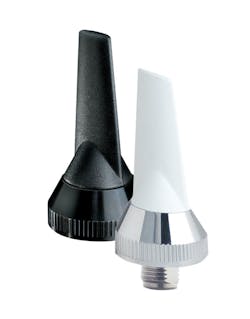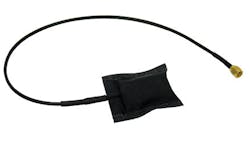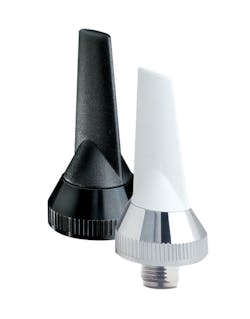Antenna designers have long been faced with one of the more challenging tasks for any component in a high-frequency system: deliver reliable performance without physically calling attention to the component. Newer antennas may support multiple frequency bands, but they must do so with the smallest physical profile possible. As a result, antennas are being designed in more creative ways, such as body-worn components or as conformal arrays that fit the shapes of their target systems. Still, they are counted upon to transmit and receive reliably, and often under less-than-ideal environmental conditions.
As wireless services continue to extend outward in support of voice, data, and video for commercial sectors, antennas are being designed to handle multiple frequency bands [such as cellular and wireless-local-area-network (WLAN) bands] in a departure from traditional antenna designs for single-function use. The latter category includes radio antennas for amplitude-modulated (AM) and frequency-modulated (FM) radio bands, as well as television antennas for very-high-frequency (VHF) and ultra-high-frequency (UHF) broadband bands. An emerging application area in commercial and military antenna applications is for ultrawideband (UWB) communications, in which a large continuous segment of bandwidth must be covered.
Of course, the market for “textbook” UWB communications applications from 3.1 to 10.6 GHz may not emerge in the consumer world, with only variants to appear in military applications such as for communications with unmanned aerial vehicles (UAVs) and unmanned ground vehicles (UGVs). Current definitions for UWB frequencies vary from manufacturer to manufacturer, but the principle of the antennas is to provide adequate bandwidth to enable multiple communications functions.
For example, the Fractus Media+™ UWB Chip Antenna from Fractus is a monopole UWB chip antenna that measures just 10 x10 x 0.8 mm, making it well suited for adding short-range wireless capability to digital cameras and other consumer electronic devices. The tiny antenna operates with more than 60% radiation efficiency and more than 4 dBi gain from 3.1 to 5.0 GHz using linear polarization. It exhibits less than 2.0:1 VSWR and works across operating temperatures from -40 to +85°C.
Perhaps closer to the classic definition of UWB frequencies spanning 3.1 to 10.6 GHz, Pharad developed its octane® wearable UWB antenna (Fig. 1) for applications from 3 to 10 GHz. The UWB antenna can be integrated with military helmets and tactical vests, and includes a waterproof cover. Like the Fractus chip antenna, it works with vertical polarization and delivers 0-dBi gain at 3 GHz, 5-dBi gain at 6 GHz, and 3.5-dBi gain at 9 GHz. It can handle as much as 5 W power with less than 2.50:1 VSWR. The wearable UWB antenna measures just 2.25 x 2.00 in. with a 16-in. cable terminated in an SMA connector. The antenna offers a near omnidirectional pattern with less than 2 oz. radiator weight.
1. The octane® wearable antenna can handle UWB communications from 3 to 10 GHz. (Photo courtesy of Pharad.)
Another UWB design from OMRON Corp. is the model WXA-N2SL surface-mount polymeric antenna; this offering is taking aim at the WiMedia Alliance UWB BandGroup 1 (from 3.1 to 4.9 GHz). The antenna is optimized for this frequency range and can effectively suppress out-of-band noise to function in the manner of a wireless Universal Serial Bus (USB). Yet another UWB antenna design is the BroadSpec™ planar elliptical dipole antenna from Time Domain, designed for use with the firm’s PulseON 400 ultrawideband module. The antenna yields about 3 dBi gain from 3 to 6 GHz with an omnidirectional radiation pattern and about 90% nominal radiation efficiency.
Research-Based Requirements
Research applications typically drive exotic requirements for antennas. The US National Oceanic and Atmospheric Administration (NOAA) and its Environmental Technology Laboratory recently posted its need for performing wide-area mapping of soil moisture and salinity by means of an advanced antenna system and receiving electronics. The application calls for a large scanning antenna with aerodynamic form, narrow beamwidth, high efficiency, and dual polarization.
What poses a challenge for antenna designers is that the antenna system must operate at L-band frequencies from 1400 to 1427 MHz as well as at C-band frequencies from 6.0 to 6.5 GHz. It must deliver stable performance even with changes in environmental conditions. One of the proposed solutions for this antenna system, by FIRST RF Corp., involves the use of dual-polarized antennas to cover the two different frequency bands. The feeling is that a combined-frequency antenna would compromise the performance of either frequency and pose additional complexities in the antenna’s radome structure.
Satellite-communications (satcom) antennas are usually associated with fixed installations, but can also be called upon for mobile applications, such as onboard aircraft. Rantec Microwave Antennas, a leading supplier of space-qualified antennas, has long offered 11.5-in.-diameter airborne antennas for Ku-band transmit/receive satcom applications. The firm has also developed Ka-band airborne satcom antennas that can replace earlier Ku-band airborne antennas while achieving 48.6 dBW output power at 1-dB compression using dual circular polarization. The Ka-band antenna, with its 12-in. aperture, handles two frequency bands: band 1 with receive range of 19.5 to 20.2 GHz and transmit range of 29.0 to 30.0 GHz and band 2, with receive range of 20.2 to 21.2 GHz and transmit range of 30.0 to 31.0 GHz. The satcom antenna is designed for 11 A at +28 VDC and weighs 26 lbs. It is built for operating temperatures from -55 to +60°C.
Because the growing modern communications infrastructure relies so heavily on antennas, some companies such as CommScope have tried to simplify and improve the task of making microwave backhaul connections between cellular communications sites. The firm’s Sentinel line of antennas are designed to deliver European Telecommunications Standards Institute (ETSI) Class 4 performance in smaller, more compact units that enable efficient use of spectrum and easy installation and maintenance. The rugged antennas are built to survive wind speeds to 250 km/h (155 mph). They support higher-order modulation schemes for high capacity, and provide 10 dB or more off-axis interference discrimination.
A circuit technology that is receiving more attention among antenna designers, substrate integrated waveguide (SiW) technology, combines the traits of microstrip circuits and larger waveguide structures. It starts with a printed-circuit-board (PCB) substrate, with top and bottom metal layers forming effective waveguide walls. Parallel rows of viaholes are added to form the sidewalls of a waveguide structure on the PCB, including integrated antennas and filters. SiW technology, which can be manipulated with the aid of electromagnetic (EM) software simulation tools, can be used for form compact cavity-backed antenna structures. The EM software enables a designer to try possible layouts without fabricating them, closely projecting the performance levels from each approach.
2. This low-profile UHF antenna provides 3-dBi gain in a housing that is only 3.4 in. high. (Photo courtesy of Laird Technologies.)
Among traditional antenna designs, such as for UHF communications, Laird Technologies managed to create a low-profile UHF antenna that is only 3.4 in. high: it’s Phantom Elite® UHF antenna (Fig. 2). The antenna design, which has earned several US patents, is suitable for public safety, military mobile, and fixed-radio applications. The compact design is capable of power levels to 100 W across different segments of the frequency range from 410 to 512 MHz using vertical polarization. The antenna achieves an omnidirectional radiation pattern with 3-dBi gain and better than 2.0:1 VSWR.
About the Author
Jack Browne
Technical Contributor
Jack Browne, Technical Contributor, has worked in technical publishing for over 30 years. He managed the content and production of three technical journals while at the American Institute of Physics, including Medical Physics and the Journal of Vacuum Science & Technology. He has been a Publisher and Editor for Penton Media, started the firm’s Wireless Symposium & Exhibition trade show in 1993, and currently serves as Technical Contributor for that company's Microwaves & RF magazine. Browne, who holds a BS in Mathematics from City College of New York and BA degrees in English and Philosophy from Fordham University, is a member of the IEEE.


